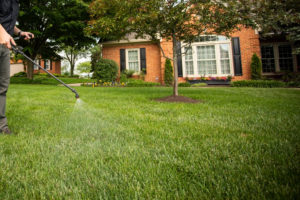
Proper Care And Safety Of Fertilizer
Here are 8 fertilizer safety tips to keep in mind as you’re investing in good lawn care:
- Pay attention to all lawn care fertilizer labels.
- The terms “Natural” and “Organic” don’t mean “Safe.” Natural or organic-based fertilizers can still be harmful to children and pets.
- Make sure you’re wearing protective clothing such as gloves and safety glasses.
- Be careful when fertilizing. Checking the weather and general tidiness can go a long way.
- Keep your lawn clear after you fertilize. “Re-entry” time is the point at which the product has fully dried or settled into the grass—making it safe for people and animals to use the lawn again.
- Store products safely. Fertilizer-related accidents don’t only occur outdoors. It’s critical that you protect your family inside the home as well.
- Know what to do in case of an emergency. Be sure to call 911, your veterinarian, or the poison helpline right away.
- Don’t fertilize too early. If you do so, your grass won’t actually use nutrients from the soil until it is actually green and growing.
What To Do With Grass Clippings After Mowing
Grass clippings will always be a part of lawn care. You can bag clippings or recycle them by returning them to the lawn. As a general rule, grass clippings of an inch or less in length can be left on your lawn where they will filter down to the soil surface and decompose quickly. Grass clippings serve as a great natural fertilizer, helping lawns grow lush and green. By leaving the clippings on the lawn, you add nitrogen to the soil and the added moisture of the clippings helps feed and water the freshly cut grass.
Why Add Compost To Your Lawn
Topdressing a lawn with compost adds organic matter to the soil, which provides for proper drainage and better tilth. That organic matter also hosts beneficial microorganisms that turn organic fertilizer and minerals in the soil into plant-available nutrients that can be taken up by roots. You can create compost out of a wide range of kitchen scraps, paper, and cardboard waste, plus grass clippings if you bag the grass when mowing. You can also start a compost pile in your garden as compost is decayed organic matter that plants need to grow. To do so, choose an area in your yard and begin adding waste in layers, kitchen scraps, dry leaves, and soil, then fresh weeds, shredded paper, and soil. A good compost pile contains a mixture of green materials, such as grass clippings, and dry materials like leaves and straw. Compost piles composed of un-shredded materials and left unattended may take a year or longer to decompose. The timing of compost pile construction is another important factor. Compost piles prepared in fall will not be ready until early summer of the following year. Compost piles constructed in spring should be ready in mid to late summer.
Does Overseeding Your Lawn Really Work?
Overseeding newer turfgrass varieties into an older lawn can help it better withstand insects, disease, drought, shady conditions, and heavy traffic. The investment in overseeding pays off by reducing the amount of fertilizer, water, and pesticides required. Grass gets old after a few years and can’t germinate the way it used to. Worn-out lawns invite weeds, disease, and insects to come to make a home in your lawn. Even if your lawn is looking healthy right now, overseeding is an inexpensive way to ensure that it stays that way all year long. Just remember spring is also the time for preemergent herbicides. Once a preemergent is put down in the spring, you cannot effectively seed until fall. If you choose to seed in the spring, hold off on the preemergent treatment. You can do the preemergent after the newly planted grass has been mowed a few times.
Have You Ever Considered A Professional Lawn Care Service?
These are the top five benefits of hiring a pro to take care of your lawn:
- Avoid Accidental Damage: A recent survey found that a large chunk of Americans are lost when it comes to basic lawn care.
- Less Physical Labor: Lawn care is labor-intensive and it’s not uncommon for people to experience sore muscles or even injuries after spending a day taking care of their yard.
- Save Money: Think about it this way. How much would you have to spend on the equipment, chemicals, and other products required to properly care for your lawn?
- Consistent Care: As a busy homeowner, it can be hard to establish and stay on top of an effective lawn care routine.
- Increased Home Value: A well-kept front and backyard will seriously boost your home’s curb appeal.
Contact us (859-314-LAWN) for more information or a free instant quote!
—
 About Green & Grow
About Green & Grow
Green & Grow is a full-service lawn care company specializing in fertilization & weed control, aeration & seeding, insect control, and more!

 About Green & Grow
About Green & Grow